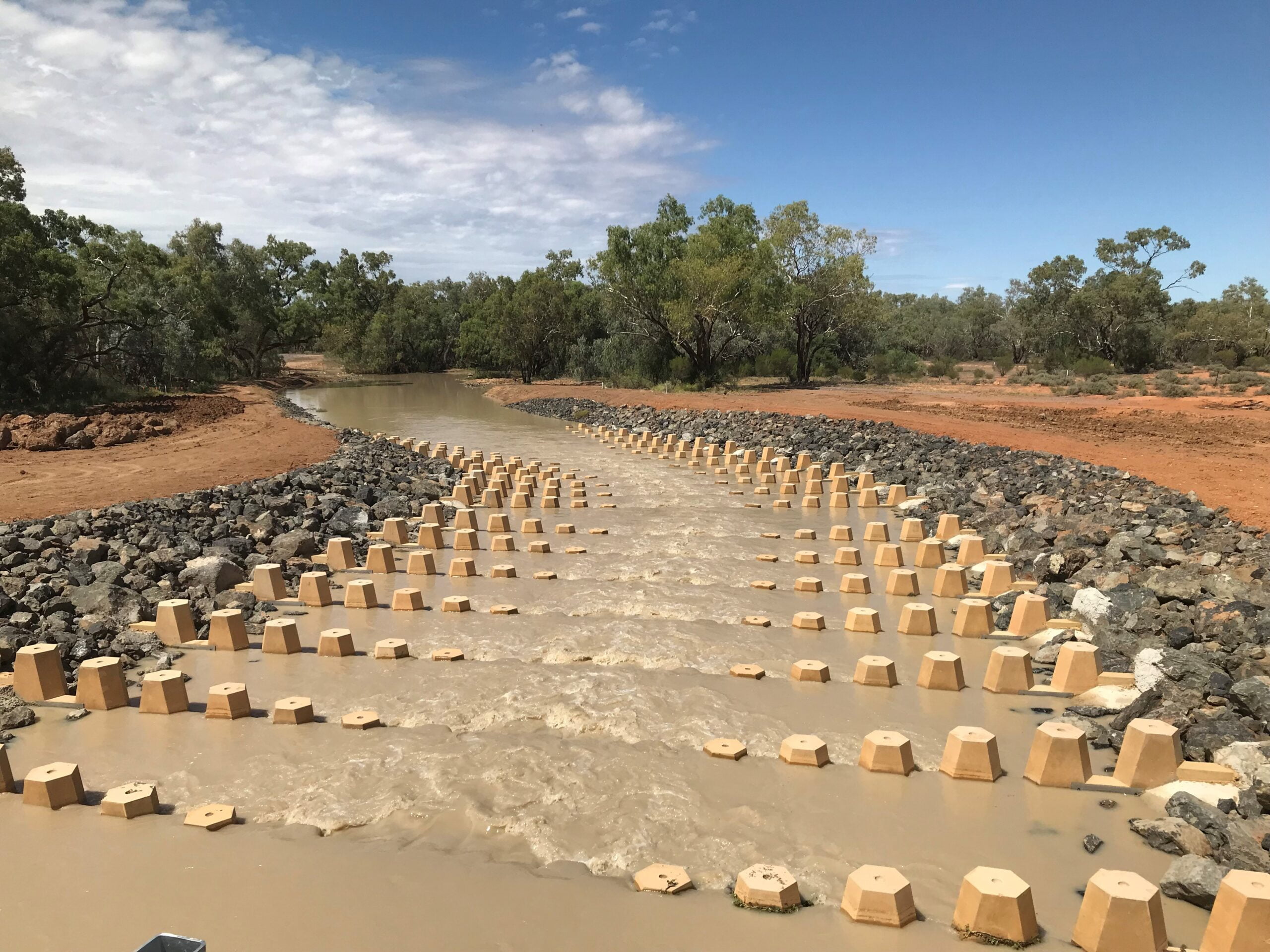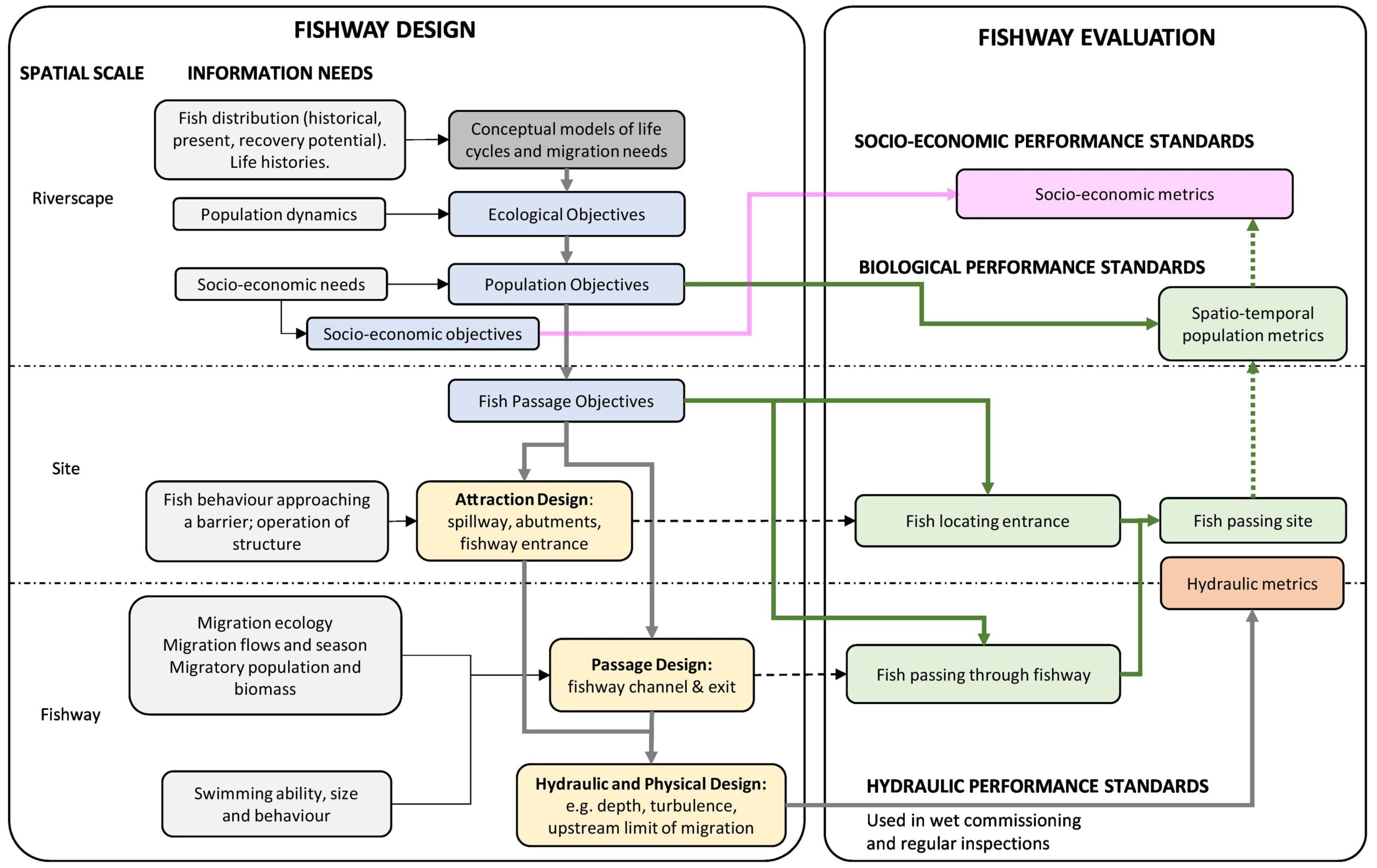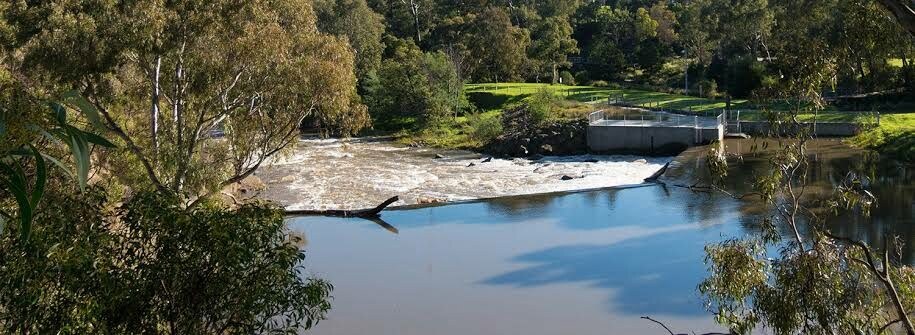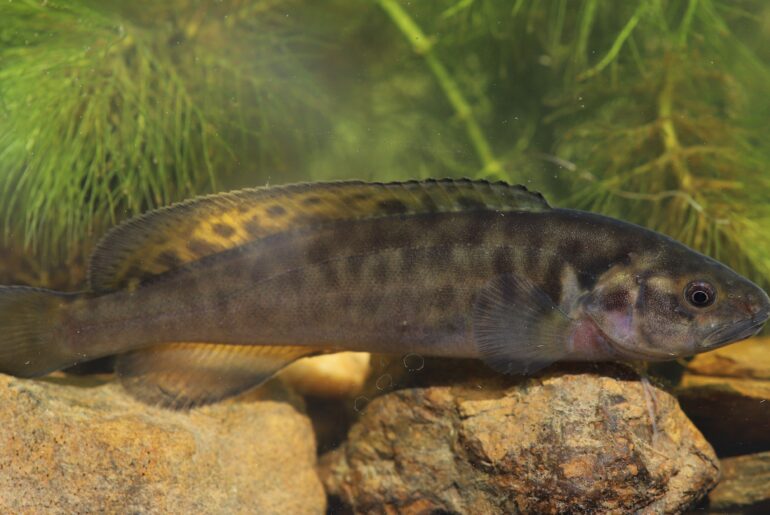In response to the fragmentation of rivers and streams, fishways have become a popular method of mitigating the impacts of dams and weirs by helping to; facilitate fish movement and migration and create access to habitats. Habitat fragmentation poses a great risk to biodiversity, with riverine fish species particularly vulnerable to human development.
A recent paper by Justin O’Connor, Robin Hale, Martin Mallen-Cooper, Steven J. Cooke, and Ivor Stuart called, Developing performance standards in fish passage: Integrating ecology, engineering and socio-economics, highlights that successful fish passage projects have clear ecological objectives and criteria to measure fishway success. This article presents some of the case studies and findings of this paper.


Whilst published evidence shows fishways are effective, some studies have shown them to be highly variable. A review by Bunt et al. 2012, showed success rates for fish passage in fishways ranging from 0-100%. This extreme variability has led to uncertainty about what acceptable fish passage and fishway performance looks like. Fishway performance targets and criteria are not often agreed upon or even widely spoken about. The literature review by O’Connor et al. 2022 found that recent fishway assessments from 2019-2021 lack concise biological and hydrological reasoning to set evaluation targets. Often, when assessments of fishways are conducted, there is no clear link back to the fishway design objectives, therefore failure and success are difficult to define. Evaluations also tend to focus on passage at the site scale, and yet fish passage objectives are likely to be spread across different spatial (fishway, dam site, river catchment), and temporal (hour, day, season, single generation, multiple generation) scales. In order to improve the performance of fishways, transparent ecological objectives need to be set along with criteria by which to measure how effective they are.
There are three different categories to look at regarding fishway projects: (i) users of the ecosystem services, who have specific objectives, (ii) fishway designers (fisheries engineers, fish biologists), who need to balance cost versus function and objectives, and (iii) scientists assessing fish passage, who may or may not have been involved in fishway design. In separating these three groups, it creates further division of evaluation and objectives. There is a clear need for a holistic approach to fishway performance standards for a variety of different groups and settings.

The above diagram represents the steps and information that must be considered for integrated design and evaluation of fishways. There are three types of performance standards that apply at three spatial scales: socio-economic standards at the riverscape scale; biological standards to riverscape, site and fishway scales; and hydraulic standards that apply at the site and fishway scales. This conceptual framework, developed in a study by O’Connor et al. 2022, aims to inform the performance standards of fishways within a broader process. The framework includes objective setting, fishway design and assessment, and outlines key principles in the development of fishway performance standards.
Case Studies
Within O’Connor et al. 2022, the study provides us with four separate case studies, each with either: i) no performance standards; ii) a generic fish passage standard; iii) a comprehensive set of standards, but not all applied; and iv) performance standards being retrospectively developed for a structure that has been in operation for >50 years. Whilst each case study is extremely different, they each highlight gaps in the reviewing process.
Engineer Sérgio Motta Dam (Paraná River, Brazil)
- Where performance standards and metrics are not explicit then the reader (or owner/manager) are unable to undertake a quantitative evaluation on whether the fishway is effective, or requires adjustment, or replacement.
- Where performance standards and metrics have been considered these need to be made available in accessible literature.
Xayaburi Dam (Mekong River, Laos PDR)
- The challenge of setting a generic fish passage standard (i.e. 95% passage) and then measuring these in a large tropical river with high fish biodiversity with widely varying migratory ecology.
- Whether or not the generic standard (i.e. 95% passage) is applicable at multiple barriers for achieving the desired population and ecological objectives, reiterating the need for monitoring and/or modelling populations.
- The importance of applying performance standards at a catchment scale rather than an individual site scale.
Dights Falls Weir (Yarra River, Australia)
- The initial emphasis on site-scale performance metrics and standards, which is very common in fishway science.
- The absence of socio-economic metrics, also common in fishway science.
- The recognition that population metrics needed to be included.
- The high resource demands for evaluating some performance standards and metrics mean these remain aspiration (i.e. energetic cost of fish passage, potentially raised fish stress levels, increased disease or predation) and their contribution to understanding population and ecological objectives needs to be carefully evaluated.
- For some sites and species there remains an inability to determine if the performance metrics have been met i.e. attraction efficiency of small fish species (< 50 mm long).
- Where performance standards and metrics have been considered these need to be made available in accessible literature.
Seton Dam (Seton River, Pacific Northwest)
- Many dams with fishways have existed for decades, well before performance standards were being considered.
- The Seton Dam and Fishway are such an example where the construction occurred in 1956 with little biological assessment of fish passage until 50+ years later.
- A Fish Passage Framework has been developed but it remains unclear how it applies to existing facilities.
- In British Columbia there are Indigenous rights holders and associated Indigenous governments that must be involved with identifying performance standards.
- Given opportunities to refine fishway operations or infrastructure to enhance passage, having clear targets and standards would help with discussions about various (and often complex) trade-offs (e.g., generation, flow releases, water temperature and total dissolved gas management) that also need to be considered.
- Fish passage performance standards will likely be embedded within broader restoration plans for the watershed and may be implied rather than specific to passage.
- Decisions on operational strategies will need to balance a suite of performance measures that extend beyond fish passage.
The study acknowledges that fishway performance standards are often difficult to apply and site-specific. When combined with riverscale metrics of populations or socio-economic values, however, it can be seen whether or not the fishway is meeting its objectives.
Fishways are clearly an important tool in managing the fragmentation of freshwater systems and the science behind them is constantly evolving. There is a need to increase focus on setting, evaluation, and adaptive alteration of performance standards to better their performance and function in ecosystem restoration. Science is now at a critical point where established fishways can now be reviewed and improved through the establishment of performance standards for future development.
To read the full journal article by Justin O’Connor, Robin Hale, Martin Mallen-Cooper, Steven J. Cooke, and Ivor Stuart, please click here.
You can also read more on fishways and their performance here:
Main photo: Dights Falls with fishway.
Photo credit: Trekking Australia




